RBSE Solutions for Class 12 Chemistry Chapter 13 Amines
Rajasthan Board RBSE Solutions for Class 12 Chemistry Chapter 13 Amines Textbook Exercise Questions and Answers.
Rajasthan Board RBSE Solutions for Class 12 Chemistry in Hindi Medium & English Medium are part of RBSE Solutions for Class 12. Students can also read RBSE Class 12 Chemistry Important Questions for exam preparation. Students can also go through RBSE Class 12 Chemistry Notes to understand and remember the concepts easily.
RBSE Class 12 Chemistry Solutions Chapter 13 Amines
RBSE Class 12 Chemistry Amines InText Questions and Answers
Question 13.1.
Classify the following amines as primary, secondary and tertiary.
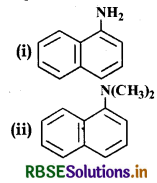
(iii) (C2H5)2CHNH2
(iv) (C2H5)2NH
Answer:
(i) Primary (1°),
(ii) Tertiary (3°),
(iii) Primary (1°),
(iv) Secondary (2°).

Question 13.2.
(i) Write structures fferent isomeric amines corresponding to the molecular formula, C4H11N.
(ii) Write IUPAC names of all the isomers.
(iii) What type of isomerism is exhibited by different pairs of amines.
Answer:
(i, ii) primary amines:
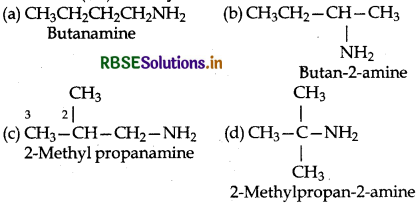
secondary amines:

Tertiary amines:

(iii) Position isomers: (a) and (b), (e) and (f).
Chain isomers: (a) and (c), (a) and (d), (b) and (c), (b) and (d).
Metamers: (e) and (g), (f) and (g).
(iv) Functional isomers: All primary (1°) amines are functional isomers of secondary (2°) and tertiary (3°) amines and vice-versa.
Question 13.3.
How will you convert:
(i) Benzene into aniline
(ii) Benzene into N,N-dimethylaniline
(iii) CI- (CH2)4-Clinto hexane-1,6-diamine?
Answer:

Question 13.4.
Arrange the following in increasing order of their basic strength:
(i) C2H5NH, C6H5NH2, NH3, C6H5CH2NH2, (C2H5)2NH
(ii) C2H5NH2, (C2H5)2NH, (C2H5)3N, C6H5NH2
(iii) CH3NH2, (CH3)2NH, (CH3)3N, C6H5NH2, C6H5CH2NH2
Answer:
In general, the basic strength of ammonia (NH3) and amines is related with the availability of the lone pair of nitrogen atom. In other words, these are Lewis bases. The relative strength of an acid or base is the extent to which it ionizes when dissolved in water. If the ionization reaction is essentially complete, the acid or base is termed strong; if relatively little ionization occurs, the acid or base is weak The K, values are:
|
NH3 (1.8 x 10-5) |
CH3NH2 (4.5 x 10-4) |
(CH3)2NH (5.4 x 10-4) |
|
(CH3)3N (0.6 x 10-4) |
C2H5NH2 (5.1 x 10-4) |
(C2H5)2NH (10.0 x 10-4) |
|
(C2H5)3N (5.6 x 10-4) |
C6H5NH2 (4.2 x 10-10) |
C6H5CH2NH2 (2.0 x 10-5) |
Thus, the increasing order of basic strengths in different amines as follows:
- C6H5NH2 < NH3 < C6H5CH2NH2 < C2H5NH2 < (C2H5)2NH
- C6H5NH2 < C2H5NH2 < (C2H5)3N < (C2H5)2NH
- C6H5NH2 < C6H5CH2NH2 < (CH3)2N < CH3NH2 < (CH3)2NH

Question 13.5.
Complete the following acid-base reactions and name the products:
(i) CH3CH2CH2NH2 + HCl →
(ii) (C2H5)2N + HCI →
Answer:
(i) CH3CH2CH2NH2 + HCl → CH3CH2CH2NH3Cl-
(ii) (C2H5)3N + HCl → (C2H5)3 NHCl-
Question 13 6.
Write reactions of the final alkylation product of aniline with excess of methyl iodide in the presence of sodium carbonate solution.
Answer:
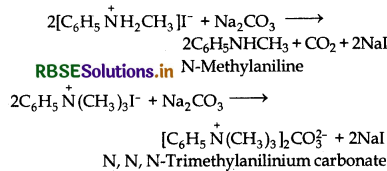
Question 137.
Write chemical reaction of aniline with benzoyl chloride and write the name of product obtained.
Answer:

Question 13.8.
Write structures of different isomers corresponding to the molecular formula, C3H9N. Write IUPAC names of isomers which will liberate nitrogen gas on treatment with nitrous acid.
Answer:
Four structural isomers are possible:
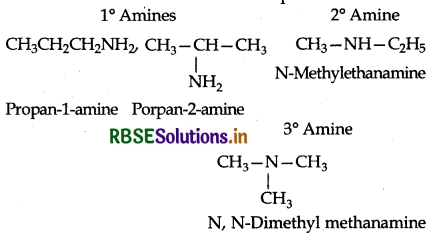
Only primary (1 °) amines react with HNO2 to liberate nitrogen gas.
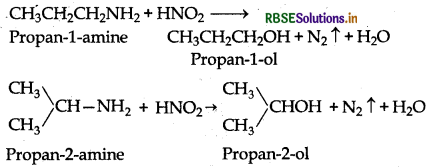
Question 13.9.
Convert (i) 3-methylaniline into 3nitrotoluene, (ii) Aniline into 1,3,5-tribromobenzene.
Answer:
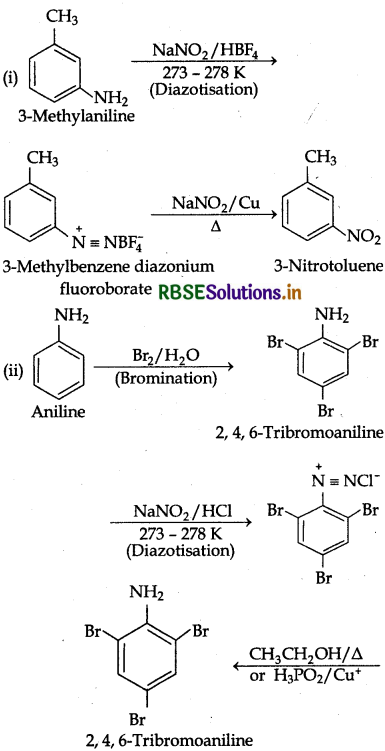
RBSE Class 12 Chemistry Amines Textbook Questions and Answers
Question 13.1.
Write IUPAC names of the following compounds and classify them into primary, secondary and tertiary amines:
(i) (CH3)2CHNH2
(ii) CH3CH2NH2
(iii) CH3NHCH(CH3)2
(iv) (CH3)3CNH2
(v) C6H5NHCH3
(vi) (CH3CH2)2NCH3
(vii) m-Br C6H4NH2
Answer:
(i) Propan-2-amine (1),
(ii) Propan-1-amine (1)
(iii) N-Methylpropan-2-amine (2°),
(iv) 2-Methylpropan-2amine (3),
(v) N-Methylbenzenamine or N-Methylaniline (2°),
(vi) N-Ethyl-N-Methyl ethanamine (3°),
(vii) 3-Bromobenzenamine or 3-Bromoaniline (1)

Question 13 2.
Give one chemical test to distinguish the following pairs of compounds:
(i) Methylamine and dimethylamine
(ii) Secondary and tertiary amine
(iii) Ethylamine and aniline
(iv) Aniline and benzylamine
(v) Aniline and N-methylaniline
Answer:
(i) Methylamine is a primary amine, therefore it gives carbylamine testi.e., when warmed with an alcoholic solution of KOH and CHCl3, it gives offensive smell of methyl isocyanide. On the other hand, dimethylamine is a secondary amine and hence does not give carby lamine test.
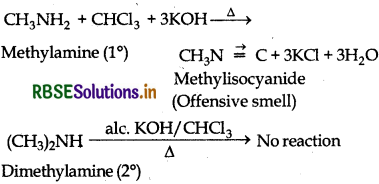
(ii) Secondary amines give Liebermann nitrosoamine test i.e., on treatment with HNO2 give yellow coloured oily nitrosoamines. For example:

N-Nitrosodiethylamine on heating with a crystal of phenol and conc. H2SO4 gives a green coloured solution which when made alkaline with aqueous sodium hydroxide turns deep blue and then red on dilution. On the other hand, tertiary amines do not give this test.
(iii) Ethylamine is a primary aliphatic amine while aniline is a primary aromatic amine. These can be distinguished by the azo dye test. In this test, the reaction of any aromatic 1° amine with HNO2 at 273 - 278 K followed by treatment with an alkaline solution of b-naphthol (2-naphthol) when a brilliant orange or red coloured dye (1-Phenylazo-2-naphthol) is obtained.
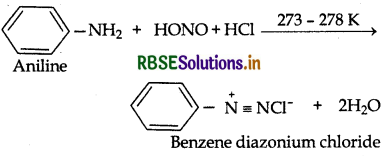
Aliphatic primary amine (e.g., Ethylamine) under these conditions gives a brisk evolution of N2 gas with the formation of 1° alcohol i.e., the solution remains clear.

(iv) Aniline and benzylamine can be distinguished by nitrous acid test. Aniline reacts with HNO2 to form stable benzene diazonium chloride at 273 - 278 K and hence does not decompose to evolve nitrogen gas.

Benzene diazonium chloride Benzylamine reacts with HNO2 to form unstable diazonium salt which decomposes with evolution of nitrogen gas.

(v) Aniline is a primary aromatic amine while methylaniline is a secondary aromatic amine. They may be distinguished by carbylamine test. Aniline being a primary aromatic amine gives carbylamine test i.e., when warmed with an alcoholic solution of KOH and CHCl3, it gives offensive smell of phenyl isocyanide. On the other hand, methylaniline being a secondary aromatic amine does not give this test.

Question 13.3.
Account for the following:
(i) pKb of aniline is more than that of methylamine.
(ii) Ethylamine is soluble in water whereas aniline is not.
(iii) Methylamine in water reacts with ferric chloride to precipitate hydrated ferric oxide.
(iv) Although amino group is o-, p-directing in aromatic substitution reactions, aniline on nitration gives a substanial amount of m-nitroaniline.
(v) Aniline does not undergo Friedel-Crafts reaction.
(vi) Diazonium salts of aromatic amines are more stable than those of aliphatic amines.
(vii) Gabriel phthalimide synthesis is preferred for synthesizing primary amines.
Answer:
(i) In aniline, the lone pair of electrons on the Natom is delocalized over the entire benzenering. As a result electron density on N-atom decreases. On the other hand, in methylamine, +I effect of methyl group increases the electron density on the N-atom. Therefore, aniline is a weaker base than methylamine and hence its pKb value is higher than that of methylamine.
(ii) Solubility of ethylamine in water is attributed to its ability to form H-bonding with water molecules as shown below:

In aniline, the non-polar hydrocarbon part is relatively larger and therefore has no interactions with polar water molecules. Hence aniline is not soluble in water.
(iii) Methylamine being more basic than water, accepts a proton from water liberating OH-ions.
CH3NH2 + H2O → CH3NH3 + OH-
These OH-ions combine with Fe3+ ions present in water to form brown precipitate of hydrated ferric oxide.
FeCl3 → Fe3+ + 3Cl-
2Fe3+ + 6OH- → 2Fe(OH)3 or Fe2O3.3H2O
(iv) Nitration is usually carried out with nitrating mixture (mixture of conc. HNO3 and conc. H2SO4). In presence of these acids, most of aniline gets protonated to form anilinium ion. Therefore the reaction mixture contains aniline (C6H5NH2) and anilinium ion (C6H5NH3). Now -NH2 group in aniline is O-, p-directing and activating while the -NH3 group in anilinium ion is m-directing and deactivating. In aniline, the probability of N+O2 attack at pposition is relatively more because of steric hindrance at m - oposition. However, in anilinium ion the attack of N+O2 mostly occurs at m-position. In actual practice approx. a 1:1 mixture of p-nitroaniline and m-nitroaniline is obtained.
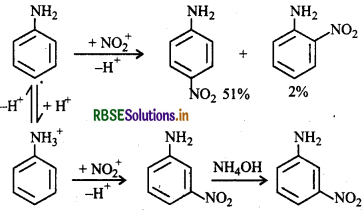
Thus, nitration of aniline gives a substantial amount of m-nitroaniline due to protonation of -NH2 (amino) group.
(v) Being a Lewis base, aniline reacts with AlCl3 (Lewis acid) to form a salt.

Due to presence of a positive charge on N-atom in the salt, the -N+H2AlCl-3 acts as strong deactivating group. As a result, the electron density in the benzene ring reduces and hence aniline does not undergo Friedel-Crafts (alkylation or acylation) reaction.
(vi) The diazonium salts of aromatic amines are more stable than those of aliphatic amines because these are resonance stabilized while no such resonance stabilization is possible in the diazonium salts of aliphatic amines.

(vii) Gabriel phthalimide reaction gives pure primary (1°) amines without contamination of secondary (2°) and tertiary (3°) amines. Therefore, it is preferred for synthesizing, primary amines.

Question 13 4.
Arrange the following:
(i) In decreasing order of pKa values, C2H5NH2, C6H5NHCH3, (C2H5)2NH and C6H5NH2.
(ii) In increasing order of basic strength, C6H5NH2, C6H5N(CH3)2 (C2H5)2NH and CH3NH2.
(iii) Increasing order of basic strength: (a) Aniline, p-nitroaniline and p-toluidine
(b) C6H5NH2, C6H5NHCH3 C6H5CH2NH2
(iv) Decreasing order of basic strength in the gas phase, C2H5NH2, (C2H5)2NH, (C2H5)3N and NH3.
(v) Increasing order of boiling point, C2H5OH, (CH3)2NH, CH-NH2.
(vi) Increasing order of solubility in water, C6H5NH2, (C2H5)2NH, C2H5NH
Answer:
(i) Higher the basic strength, lower is the pKb value. The correct order of increasing basic strength or decreasing PKb value is as follows:
C6H5NH2 < C6H5NHCH2 < C2H5NH2 < (C2H5)2NH pKb = 938 = 9.30 = 3:29 = 30
(ii) The correct decreasing order of basic strength among the given amines is.
(C2H5)2NH > CH3NH2 > C6H5N(CH3-C-NH)2 > C6H5NH2 Kb = 10 x 10-4 4.5 x 10-4 11.5 x 10-10 4.2 x 10-10
(iii) The correct increasing order of basic strength is:
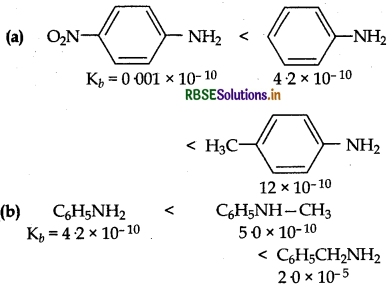
(iv) The decreasing order of basic strength in gas phase is
(C2H5)2N > (C2H5)2NH > C2H5NH2 > NH3
Here, the basic strength is determined by +I effect only. The more is +I effect around N-atom, more will be the basic strength of amine.
(v) The electronegativity of O-atom (35) is more than that of N-atom (3 0). Therefore, H-bonding is more stronger in C2H5OH. Hence, its boiling point is highest among the given species. Among amines, the H-bonding is more extensive in C2H5NH2 than in (CH3)2NH. Hence, the correct order of increasing boiling points is
(CH3)2NH < C2H5NH2 < C2H5OH Boiling point (K) 280.65 < 328.15 < 351.65
(vi) The solubility of amines in water decreases with the increase in the size of hydrocarbon part. Therefore, the increasing order of solubility in water is C6H5NH2 < (C2H5)2NH < C2H5NH2.
Question 13 5.
How will you convert?
(i) Ethanoic acid into methanamine
(ii) Hexanenitrile into 1-aminopentane
(iii) Methanol to ethanoic acid
(iv) Ethanamine into methanamine
(v) Ethanoic acid into propanoic acid
(vi) Methanamine into ethanamine
(vii) Nitromethane into dimethylamine
(viii) Propanoic acid into ethanoic acid
Answer:

Question 136.
Describe the method for the identification of primary, secondary and tertiary amines. Also write chemical equations of the reaction involved.
Answer:
primary amine:
Primary amines can be considered as compounds derived from ammonia by the substitution of one hydrogen atom with an organic radical alkyl or aryl, or as compounds resulting from the substitution of a hydrogen atom from an organic molecule with the group NH2.
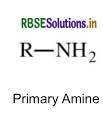
Secondary (2°) amines: Secondary amines have two organic substituents (alkyl, aryl or both) bound to the nitrogen together with one hydrogen. Important representatives include dimethylamine, while an example of an aromatic amine would be diphenylamine.
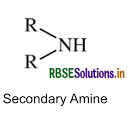
CH3N(CH3)2 and N(CH3)3 are tertiary amines tertiary amines have no hydrogen atom and three alkyl or aryl groups attached to the nitrogen.


Question 13 7.
Write short notes on the following:
(i) Carbylamine reaction
(ii) Diazotization
(iii) Hoffmann bromamide reaction
(iv) Coupling reaction
(v) Ammonolysis
(vi) Acetylation
(vii) Gabriel phthalimide synthesis.
Answer:
(i) Carbylamine reaction:
Carbylamine reaction is used as a test for the identification of primary amines. When aliphatic and aromatic primary amines are heated with chloroform and ethanolic potassium hydroxide, carbylamines (or isocyanides) are formed. These carbylamines have very unpleasant odours. Secondary and tertiary amines do not respond to this test.

(ii) Diazotization:
Aromatic primary amines react with nitrous acid (prepared in situ from NaNO2 and a mineral acid such as HCl) at low temperatures (273-278 K) to form diazonium salts. This conversion of aromatic primary amines into diazonium salts is known as diazotization. For example, on treatment with NaNO2 and HCl at 273−278 K, aniline produces benzenediazonium chloride, with NaCl and H2O as by-products.
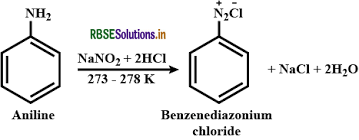
(iii) Hoffmann bromamide reaction:
When an amide is treated with bromine in an aqueous or ethanolic solution of sodium hydroxide, a primary amine with one carbon atom less than the original amide is produced. This degradation reaction is known as Hoffmann bromamide reaction. This reaction involves the migration of an alkyl or aryl group from the carbonyl carbon atom of the amide to the nitrogen atom.
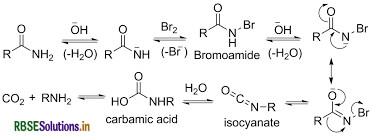
(iv) Coupling reaction:
The reaction of joining two aromatic rings through the −N = N−bond is known as coupling reaction. Arenediazonium salts such as benzene diazonium salts react with phenol or aromatic amines to form coloured azo compounds.

It can be observed that, the para-positions of phenol and aniline are coupled with the diazonium salt. This reaction proceeds through electrophilic substitution.
(v) Ammonolysis
When an alkyl or benzyl halide is allowed to react with an ethanolic solution of ammonia, it undergoes nucleophilic substitution reaction in which the halogen atom is replaced by an amino (−NH2) group. This process of cleavage of the carbon-halogen bond is known as ammonolysis.

When this substituted ammonium salt is treated with a strong base such as sodium hydroxide, amine is obtained. Though primary amine is produced as the major product, this process produces a mixture of primary, secondary and tertiary amines, and also a quaternary ammonium salt as shown.
(vi) Acetylation
Acetylation (or ethanoylation) is the process of introducing an acetyl group into a molecule.

Aliphatic and aromatic primary and secondary amines undergo acetylation reaction by nucleophilic substitution when treated with acid chlorides, anhydrides or esters. This reaction involves the replacement of the hydrogen atom of −NH2 or > NH group by the acetyl group, which in turn leads to the production of amides. To shift the equilibrium to the right hand side, the HCl formed during the reaction is removed as soon as it is formed. This reaction is carried out in the presence of a base (such as pyridine) which is stronger than the amine.
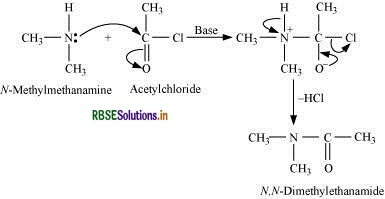
When amines react with benzoyl chloride, the reaction is also known as benzoylation.

(vii) Gabriel phthalimide synthesis
Gabriel phthalimide synthesis is a very useful method for the preparation of aliphatic primary amines. It involves the treatment of phthalimide with ethanolic potassium hydroxide to form potassium salt of phthalimide. This salt is further heated with alkyl halide, followed by alkaline hydrolysis to yield the corresponding primary amine.
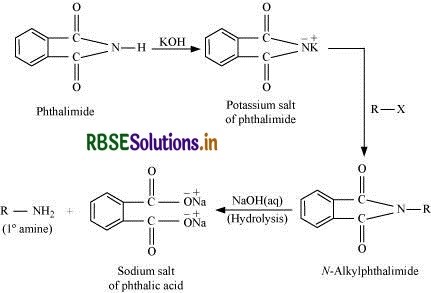
Question 13 8.
Accomplish the function reactions:
(i) Nitrobenzene to benzoic acid
(ii) Benzene to m-bromophenol
(iii) Benzoic acid to aniline
(iv) Aniline to 2,4,6-tribromofluorobenzene
(v) Benzyl chloride to 2-phenylethanamine
(vi) Chlorobenzene top-chloroaniline
(vii) Aniline top-bromoaniline
(viii) Benzamide to toluene
(ix) Aniline to benzyl alcohol.
Answer:


Question 139.
Give the structure of A, B and C in the following reactions:
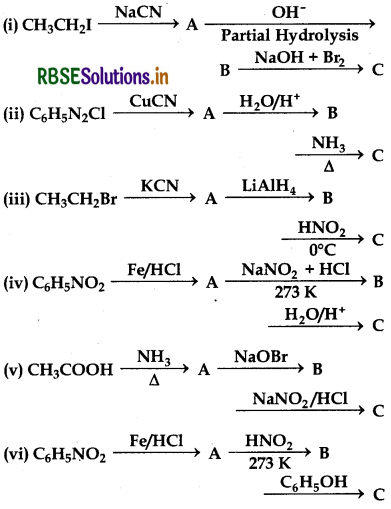
Answer:
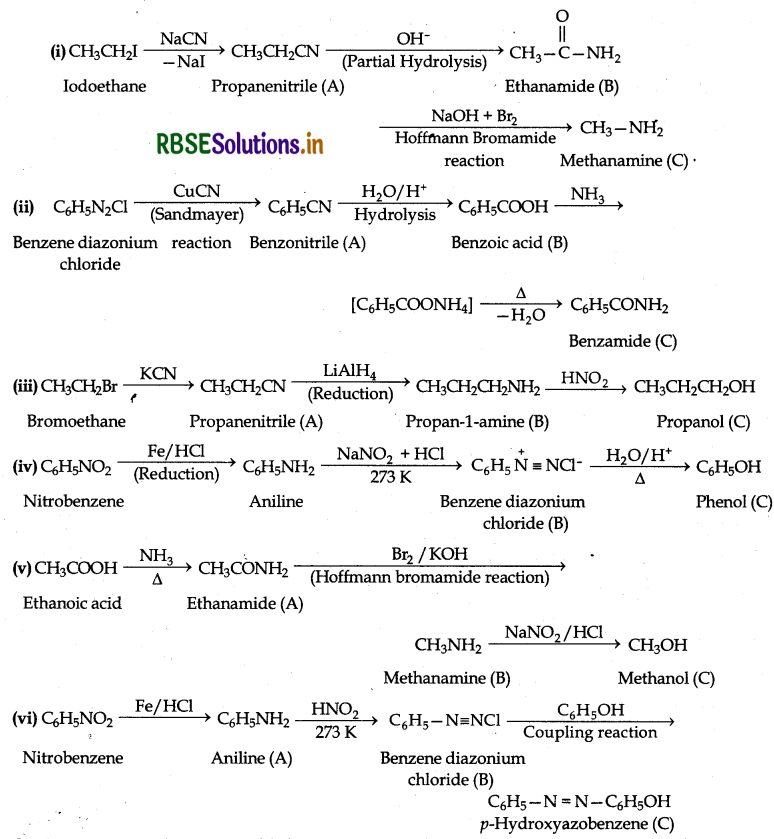
Question 13.10.
An aromatic compound 'A' on treatment with aqueous ammonia and heating forms compound ' B ' which on heating with Br2 and kOH forms a compound ' 'C' of molecular formula C6H7N. Write the structures and IUPAC names of compounds A, B, C.
Answer:
From the given information, we find that 'B' upon heating with Br2 and KOH forms a compound 'C'. The compound 'B' is expected to be an acid amide. Since 'B' has been formed upon heating compound 'A' with aqueous NH3. The compound 'A' is an aromatic acid. It is benzoic acid. The reactions involved are as follow:

Question 13 11.
Complete the following reactions:
(i) C6H5NH2 + CHCl3 + alc. KOH →
(ii) C6H5N2Cl + H3PO2 + H2O →
(iii) C6H5NH2 + H2SO4 (conc.) →
(iv) C6H5N2Cl + C2H5OH →
(v) C6H5NH2 + Br2 (aq) →
(vi) C6H5NH2 + (CH3CO)2O →

Answer:
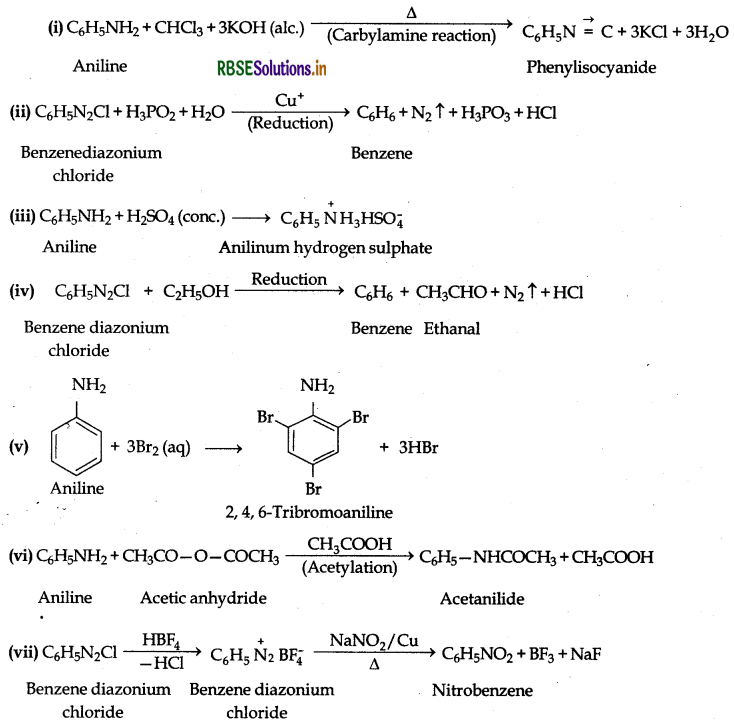
Question 13.12.
What can not aromatic primary amines be prepared by Gabriel phthalimide synthesis?
Answer:
In Gabriel phthalimide reaction, potassium salt of phthalimide is formed. It readily reacts with alkyl halide to orm the corresponding alkyl derivative.
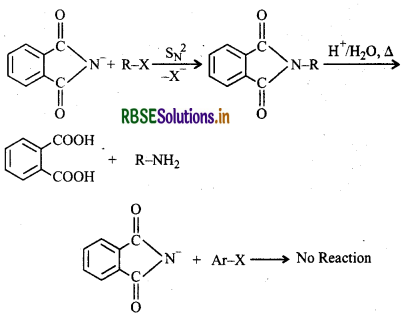
But N-alkyl phthalimide is not in position to react the aryl halide in case of primary aromatic amine is to be prepared. In actual practice, the cleavage of C - X bond in haloarene or aryl halide is quite different due to partial double bond character. Thus, aromatic amines can not be prepared by Gabriel phthalimide synthesis.

Question 13.13.
How do aromatic and aliphatic primary amines react with nitrous acid?
Answer:
aromatic primary amine:
The reaction of aromatic primary amines with nitrous acid gives aromatic diazonium salts.
aliphatic primary amine:
The reaction of aliphatic primary amines with nitrous acid gives aromatic diazonium salts which decompose to form a mixture of compounds containing alkyl chlorides, alkenes and alcohols. Usually, alcohols are the major products. The reactions are shown above.
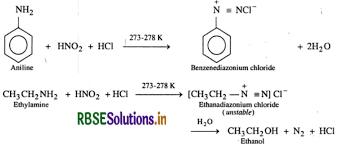
Question 13.14.
Give possible explanation for each of the following:
(i) Why are amines less acidic than alcohols of comparable molecular masses?
(1) Why do primary amines have higher boiling points than tertiary amines?
(iii) Why are aliphatic amines stronger bases than aromatic amines?
Answer:
(i) The acidic character in the both the cases is due to the release of a proton (H+).

Since O-atom is more electronegative than N-atom, therefore, RO (alkoxide ion) can accommodate the negative charge more easily than the RNH-(amide ion). Thus amines are less acidic than alcohols of comparable molecular masses.
(ii) Due to the presence of two H-bonds on N-atom of primary amine they undergo intermolecular H-bonding while tertiary amines due to the absence of H-atom on Hatom do not undergo H-bonding. As a result, primary amines have higher boiling points than tertiary amines of comparable molecular masses.

(iii) In aliphatic amines: the −NH2 group is attached to an alkyl group which is an electron donating group i.e, they have +I effect. So, the lone pair of electrons on nitrogen are readily available.
In aromatic amines: the −NH2 group is attached to a −C6H5 group, which is an electron withdrawing group. So, the availability of a lone pair of electrons on N is decreased. Therefore aliphatic amines are more basic than aromatic amines.

- RBSE Class 12 Chemistry Notes Chapter 16 दैनिक जीवन में रसायन
- RBSE Class 12 Chemistry Notes Chapter 15 बहुलक
- RBSE Class 12 Chemistry Notes Chapter 14 जैव-अणु
- RBSE Class 12 Chemistry Notes Chapter 13 ऐमीन
- RBSE Class 12 Chemistry Notes Chapter 12 ऐल्डिहाइड, कीटोन एवं कार्बोक्सिलिक अम्ल
- RBSE Class 12 Chemistry Notes Chapter 11 ऐल्कोहॉल, फीनॉल एवं ईथर
- RBSE Class 12 Chemistry Notes Chapter 10 हैलोऐल्केन तथा हैलोऐरीन
- RBSE Class 12 Chemistry Notes Chapter 9 उपसहसंयोजन यौगिक
- RBSE Class 12 Chemistry Notes Chapter 8 d- एवं f-ब्लॉक के तत्व
- RBSE Class 12 Chemistry Notes Chapter 7 p-ब्लॉक के तत्व
- RBSE Class 12 Chemistry Notes Chapter 6 तत्वों के निष्कर्षण के सिद्धांत एवं प्रक्रम